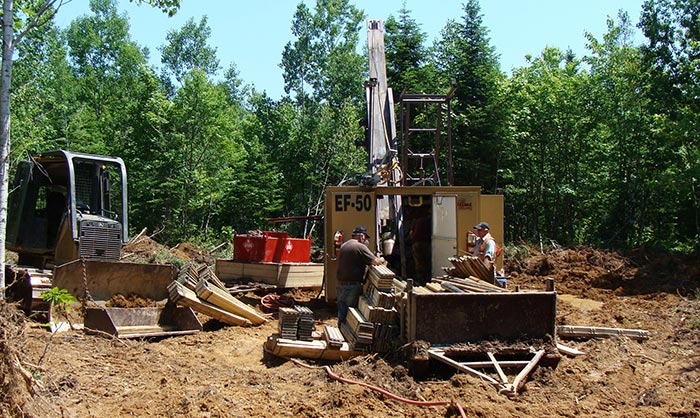VANCOUVER — It may very well be the worst market conditions for explorers, but that hasn’t stopped Wolfden Resources (TSXV: WLF) from mounting a drill campaign across its expansive land position in the heart of northeast New Brunswick’s historic Bathurst mining camp.
The company is well-funded with $1.6 million in flow-through dollars to spend over the next five months, and hopes success at a couple of targets may lead to exciting discoveries on greenfield ground.
Wolfden’s flagship asset is the Tetagouche project, which consists of over 200 sq. km along 30 km of strike of the Spruce Lake formation. The centre of the property is 30 km northwest of the prolific Brunswick No. 12 zinc-lead-silver mine and 25 km west of the city of Bathurst. Tetagouche hosts five historic massive-sulphide deposits and additional mineral occurrences, including the Armstrong A, Armstrong B, Rocky Turn, McMaster and Canoe Landing Lake deposits.
In April Wolfden added to its land position when it picked up the Brunswick No. 6 West property, comprised of 33 sq. km beside the past-producing Brunswick No. 6 mine.
“We picked up Brunswick No. 6 through staking after it was dropped by Xstrata,” Wolfden CEO George Topping said during an interview. “We noticed there was a drill hole that had a geophysical anomaly within 30 metres of the collar. The target hadn’t been drilled when the project was dropped, and it represented a fairly well-defined zone we thought was ready to go. We completed two holes, and we’re just awaiting the assays.”
Wolfden’s attention was drawn to the target area at Brunswick 6 by drill hole 12-12, which intersected over 140 metres of highly altered and mineralized Brunswick Horizon rock types. Specifically, the hole cut through a thick magnetite-chlorite iron formation underlain by a thick zone of stringer sulphide mineralization within strongly altered felsic volcanic rocks. Sampling reportedly returned broad intervals of anomalous base-metal mineralization.
“We’re drilling at another regional target called the Forks area,” Topping continued. “Since we acquired the land package back in 2012, our focus has been on the V10 area on the Tetagouche property, but we’ve expanding our efforts since finding good regional targets, as we’ve reviewed the data. The Forks is 60 km west of V10, and hosts a coincident soil and induced polarization (IP) anomaly. We’re getting quite strong soil values at the target, but again, it’s never been drilled.”
Forks hosts a prospective soil geochemical anomaly that runs 400 by 200 metres and is characterized by “highly anomalous levels” of lead, zinc, copper, silver and antimony. Closely associated with the soil anomaly is a well-defined, northeast-trending IP anomaly with by high chargeability and low resistivity.
The strong soil values in association with the IP anomaly — underlain by altered felsic volcanic rocks — suggest there could be volcanogenic massive sulphide mineralization on the property.
“We’re not turning our focus away from V10 necessarily, because we have two target areas that are being drilled there later this month,” he said. “Those areas are key for our company in the search for the bedrock source of the high-grade boulders we discovered last year. These are high-grade occurrences, and it’s definitely well-worth our time to pinpoint that source.”
Wolfden is planning a drill program at V10 with the hope of nailing down the bedrock source of boulder assays that returned up to 19.9% zinc, 3.9% lead, 0.3% copper, 649 grams silver per tonne and 1.08 grams gold per tonne.
The company has also staked 6 sq. km in east-central Manitoba, where previous work has provided “compelling evidence” of Kambalda-type nickel-copper mineralization. Topping said president Don Hoy had his eye on the land package for a “couple of years,” and the company jumped on the chance to stake the ground when it became available.
The property has intriguing exploration upside due to its spinifex-textured ultramafic flows that historic diamond drilling showed have nickel and copper.
The mineralization style often contains higher-grade platinum-group elements. Kambalda-type deposits are characterized by high nickel grades and tend to occur in clusters within the base of ultramafic flows in channel-like deposits.
“The Manitoba asset has been known to management for quite a few years. Nickel has been in a protracted bear market and there have been a lot of cutbacks in exploration. We’re still looking to stake additional ground around that deposit, so we haven’t given away its exact location. We’re flying an electromagnetic survey that will put us in a position to stake any ground we need,” Topping added.
“When things are at maximum depression you end up picking things up for cheap, or even staking them. All metals are cyclical and we all think things will eventually turn. The research I’m seeing says we could be moving into a nickel deficit next year, and that should compound over the next three years,” he continued.
Wolfden’s working capital stands at $2.6 million, including its flow-through funds. The company appears well-financed for exploration at Tetagouche, and for a “larger program” on the new nickel property later in the year.
Wolfden has traded within a 52-week range of 9¢ to 32¢, and closed at 9.5¢ per share at press time. The company has 67 million shares outstanding for a $6.4-million market capitalization.


Be the first to comment on "Wolfden keeps the drills turning in Bathurst camp"